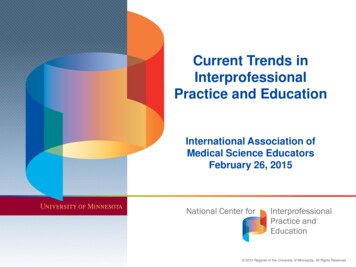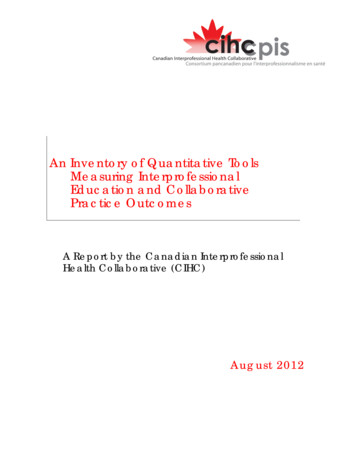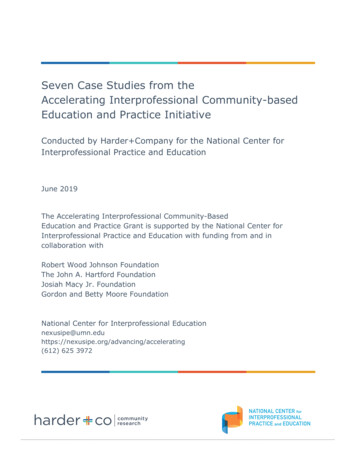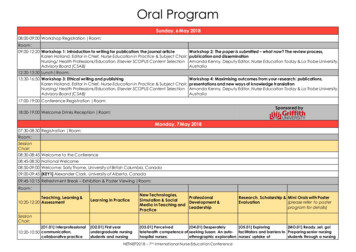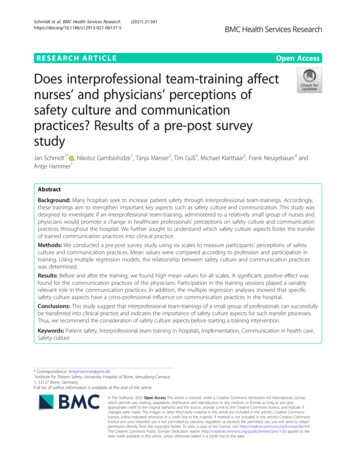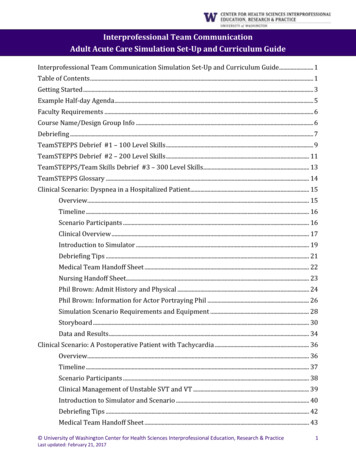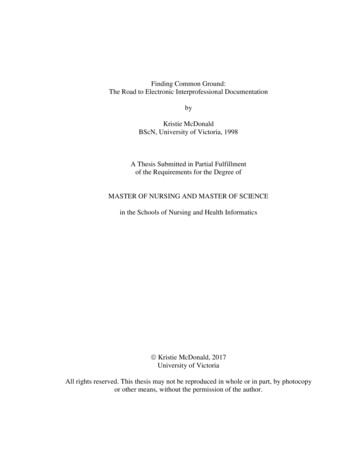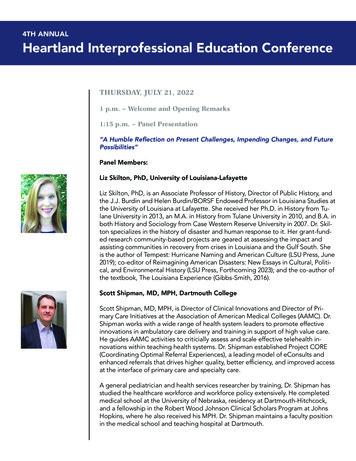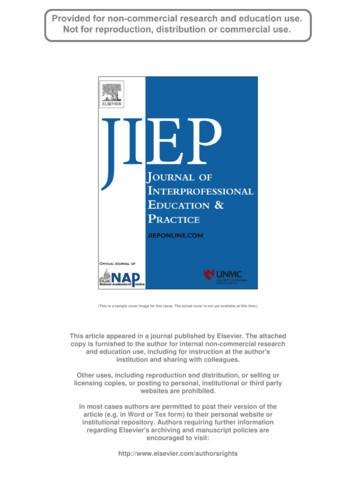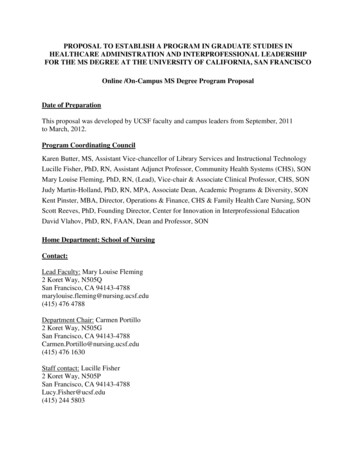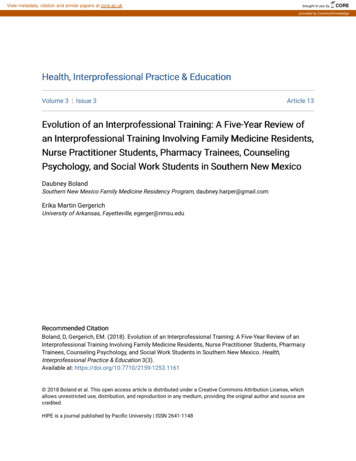
Transcription
View metadata, citation and similar papers at core.ac.ukbrought to you byCOREprovided by CommonKnowledgeHealth, Interprofessional Practice & EducationVolume 3Issue 3Article 13Evolution of an Interprofessional Training: A Five-Year Review ofan Interprofessional Training Involving Family Medicine Residents,Nurse Practitioner Students, Pharmacy Trainees, CounselingPsychology, and Social Work Students in Southern New MexicoDaubney BolandSouthern New Mexico Family Medicine Residency Program, daubney.harper@gmail.comErika Martin GergerichUniversity of Arkansas, Fayetteville, egerger@nmsu.eduRecommended CitationBoland, D, Gergerich, EM. (2018). Evolution of an Interprofessional Training: A Five-Year Review of anInterprofessional Training Involving Family Medicine Residents, Nurse Practitioner Students, PharmacyTrainees, Counseling Psychology, and Social Work Students in Southern New Mexico. Health,Interprofessional Practice & Education 3(3).Available at: https://doi.org/10.7710/2159-1253.1161 2018 Boland et al. This open access article is distributed under a Creative Commons Attribution License, whichallows unrestricted use, distribution, and reproduction in any medium, providing the original author and source arecredited.HIPE is a journal published by Pacific University ISSN 2641-1148
Evolution of an Interprofessional Training: A Five-Year Review of anInterprofessional Training Involving Family Medicine Residents, NursePractitioner Students, Pharmacy Trainees, Counseling Psychology, and SocialWork Students in Southern New MexicoAcknowledgements and FundingDisclosures: This project was supported by funds from the Bureau of Health Workforce (BHW), HealthResources and Services Administration (HRSA), Department of Health and Human Services (DHHS). Thisinformation or content and conclusions are those of the author and should not be construed as theofficial position or policy of, nor should any endorsements be inferred by the BHW, HRSA, DHHS or theU.S. Government. Acknowledgements: The authors would like to acknowledge our interprofessionalfaculty that have dedicated their time for the advancement of their trainees in inteprofessional education.We would like to specifically thank Dr. Lynette Summers, who has been a valuable faculty member sincethe start of the immersion and who contributed to this manuscript. We would also like to thank ourparticipating agencies including the Southern New Mexico Family Medicine Residency Program, NewMexico State University’s Counseling & Educational Psychology Department, School of Nursing, School ofSocial Work, and the University of New Mexico’s School of Pharmacy.This educational strategy is available in Health, Interprofessional Practice & s3/13
H IPISSN 2159-1253&Evolution of an Interprofessional Training:A Five-Year Review of an InterprofessionalTraining Involving Family MedicineResidents, Nurse Practitioner Students,Pharmacy Trainees, Counseling Psychology,and Social Work Students in Southern NewMexicoDaubney Harper Boland PhD Southern New Mexico Family Medicine Residency Program, Las Cruces, NMErika Martin Gergerich PhD New Mexico State University, Las Cruces, NMAbstractThe Affordable Care Act (ACA, 2010) embraced the “triple aim” in healthcare to enhance health, promote better care,and reduce cost. The use of healthcare teams can improve patient care, health outcomes, and reduce medical errors(Earnest & Brandt, 2014). However, building healthcare teams goes beyond placing people of different healthcareprofessions together, it requires the integration of the healthcare disciplines, a valuing of each other’s roles, and theability to communicate and work together (IPEC, 2011). The term “interprofessional” reflects interdependence, sharedresponsibility, and reliance on each other to best accomplish a task. These values often run counter to traditional valuesof independence, individual responsibility, and siloed expertise that are still taught in many professional educationprograms. This article will review the development of an interprofessional training program and insights learned byfaculty as this training evolved. This training experience, called the Interprofessional Immersion, brought togethertrainees in multiple healthcare professions including family medicine residents, nurse practitioner students, pharmacystudents, social work students, and counseling psychology students. This program was designed to develop the skillsneeded to effectively work within an interprofessional healthcare team. This article will review lessons learned from thefirst five years the Interprofessional Immersion was implemented.Received: 04/20/2018 Accepted: 08/06/2018 2018 Boland & Gergerich. This open access article is distributed under a Creative Commons Attribution License, which allows unrestricted use, distribution, and reproduction in any medium, provided the original author and source are credited.Health & Interprofessional Practice commons.pacificu.edu/hip3(3):eP1161 1
H IP&IntroductionOver the past decade, healthcare in the United Stateshas struggled to provide positive health outcomes.When compared to other countries, the U.S. has a veryexpensive healthcare system with relatively poor healthoutcomes (Murray, Phil & Frenk, 2010). The AffordableCare Act (ACA) was implemented to help reduce cost,promote better health outcomes, and increase job satisfaction among healthcare providers (Davis, Abrams, &Stremikis, 2011). An interprofessional approach to careaims to address these goals. The World Health Organization has amplified the need for such a shift/approachto be adopted by global health institutions and workers (WHO, 2010). As the World Health Organizationhas suggested, “It’s no longer enough for health workersto be professional. In the current global climate, healthworkers also need to be interprofessional” (WHO, 2010,p. 36). The World Health Organization has stated thatinterprofessional practice can reduce the cost of care,improve health outcomes and decrease staff turnover.Such outcomes align with the above mentioned goalsof the Affordable Care Act (WHO, 2010).This article will discuss how building healthcare teamsgoes beyond placing people of different healthcare professions together. Building an effective interprofessional team has important implications for both patients,professionals, and the healthcare system as a whole.Robben et al. (2012) point out, “ problems in collaboration and coordination between professionals cannegatively affect patient outcomes, lead to decreasedwork satisfaction of professionals, and result in wasteof resources” (197).Thus, it is vital that healthcare professionals learn howto work together. The Interprofessional Education Collaborative (IPEC) was established in 2009 to supportthe development of effective healthcare teams andidentify core competencies to assist with integration.The Collaborative has expanded to include associationsof higher education from 20 various fields of medicalpractice. The core competencies established by IPECinclude learning the values and ethics of different professions, understanding each other’s roles, learning tocommunicate effectively, and building/honing skills towork as a team (IPEC, 2011). These competencies werekept broad, so that various program curricula couldalign with profession-specific standards as well as IPECcompetencies simultaneously (IPEC, 2016).EDUCATIONAL STRATEGYEvolution of an Interprofessional TrainingAn important approach to help develop interprofessional competencies among healthcare staff is to starttraining while they are still in student roles. One studyof an interprofessional training included family medicine residents, pharmacy students, third year doctoral level counseling psych and doctoral level nursingstudents. Findings indicated that students who participated in the interprofessional training reported animproved ability to work in teams following participation in the educational program (Boland, Scott, Kim,White & Adams, 2016). Traditional physician trainingmay not overtly include other health professionals, andthere is a clear chain of command that includes tiers ofleadership from medical student up to senior attendingphysician (Leipzig et al., 2002). Researchers have therefore suggested that interprofessional education that emphasizes teamwork and shared decision-making shouldtake place even prior to residency (Leipzig et al., 2002).Learning while in student roles may also create an opportunity to level potential power dynamics and hierarchies that often exist across healthcare professions.Members of interprofessional healthcare teams oftenacknowledge that physicians hold the most authorityin the group (Delva, Jamieson & Lemieux, 2008). Onestudy utilized the Attitudes Towards Health Care TeamsScale and indicated that a change in views of leadershipamong social work students took place following interprofessional training. After participating in an interprofessional education program, social work studentshad a lowered perception that physicians hold the finalauthority for making healthcare decisions (Bonifas &Gray, 2013).With this knowledge, the healthcare education community in Las Cruces, New Mexico has worked todevelop interprofessional training. One of these trainings, the Interprofessional Immersion, aims to teachinterprofessional collaboration and change the cultureof healthcare delivery among our trainees. This articlewill discuss our training components and ways thatthe program has evolved over time, as we moved awayfrom siloed care to an integrated and interprofessionalapproach.The Interprofessional ImmersionThe Interprofessional Collaborative is a group of trainers in different healthcare fields and settings that worktogether each year to teach and promote integratedhealthcare. This group consists of faculty from New3(3):eP1161 2
H IPISSN 2159-1253Mexico State University from the Counseling Psychology, Nursing, Social Work, and Anthropology programs, the University of New Mexico’s School of Pharmacy, and Southern New Mexico’s Family MedicineResidency Program. This collaborative has trained 139students from 2013-2017 from different healthcare professions including counseling psychology, social work,nurse practitioners (family medicine and psychiatric),pharmacy, family medicine physicians, and medical anthropology.Trainees were in different stages of their programsbased on availability and coursework/curriculum ofthe corresponding program. Psychology trainees werein their third year of their doctoral program and aboutto enter into a primary care practicum. Family medicine physician residents were in their first year (during their second week) of residency to help with culturechange and onboarding into an interprofessional residency program. The doctoral nurse practitioner program trainees were beginning their first clinical rotations. Due to the limited number of pharmacy trainees,these students were in various years of their programand included several pharmacy residents in a one-yearclinical residency program. The social work studentswere beginning their first clinical practicum in a primary care setting. The medical anthropology studentswere bachelor’s level students on a qualitative researchteam. This five-year study was approved by NMSU’s institutional review board.Year One - 2013The Interprofessional Immersion began in 2013 as theresult of a HRSA funded grant focused on interprofessional training within geriatric care. The facultyinvolved hoped to enhance collaboration with otherhealthcare professionals; however, at the close of thetraining it became clear to faculty through observationand an outside evaluator, that the immersion furtherrepresented silos and separation between healthcareprofessions. The faculty taught separately and did notshow collaboration in their presentations. Althoughtrainees were encouraged to work together, the formatof the training made this difficult. The educational program took place in a large auditorium and the majorityof the week-long training utilized PowerPoints and alecture format. There were, however, some opportunities for trainees to work alongside others from differenthealth professions while on rounds and using telemediHealth & Interprofessional Practice commons.pacificu.edu/hip&cine kits. These trainees were divided into groups withrepresentation from different professions.In the 2013 immersion, trainees reported that they didnot feel closer to other professions nor did they indicate feeling more apt to work with their counterparts inthe future. The following comments are from studentevaluations from the training.One student commented:Perhaps it would be helpful to have exercises to facilitatelistening skills of providers who have not been trainedin that. This was an issue for my team not only betweenteam members but also in interactions with the patient.Another student stated, “The [medical] resident did notreally grasp the purpose of an interprofessional, integrated approach and enforced a hierarchy of professions.”A third student reflected, “Communication between thedifferent professions is challenging as well as obtainingmutual respect.”The faculty soon learned that simply putting differenttrainees together was not “interprofessional” and thattraining would need to facilitate a team-based approachto learning and care delivery.Additionally, power and hierarchy are often presentin healthcare settings and can be a source of conflict(Schaik, Plant & O’Brien, 2015; Schaik et al., 2014; Baker et al., 2011; Lingard et al., 2012; Brown, Lewis, Ellis, Stewart Freeman, & Kaperski, 2011). These issues,however, were neither discussed nor addressed by thefacilitators of the training.Year Two - 2014In evaluating the first year of the Interprofessional Immersion, the faculty decided that training was neededfor the trainers. Core faculty attended a two-day training with interprofessional education (IPE) trainersfrom the University of Washington. Additionally, thefaculty felt that the immersion needed to facilitateteam-based learning, change the learning environmentto support group work, and incorporate interprofessional education competencies through the event. Forthe second year of the immersion, the space utilizedfor education was a large classroom with round tables,encouraging small group discussion. Trainees wereplaced into groups at each round table; groups were3(3):eP1161 3
H IP&made up of one trainee from each profession. Traineeswere required to reflect on their experiences each daythrough an online program; students were required tocomplete daily readings and journal entries. Additionally, there was some variation in team schedules dueto availability of faculty. Measures used included theTeam Skills Scale (Hyer, Heinemann, & Fulmer, 2002),the Attitudes Towards Healthcare Teams (Heinemann,Schmitt, Farrell, & Brailler, 1999; Hyer, Fairchild, Abraham, Mezey, & Fulmer, 2000), a measure the team created that assessed for level of confidence in the fourcore domains of the IPE competencies which was nota validated instrument, and daily journal entries. Giventhat the focus was also on geriatric care, the faculty included a measure to assess trainees’ level of empathy inworking with geriatric populations. Due to challengeswith participant identifiers and the computer programused to house the data, faculty were unable to analyzequantitative data. However, students did complete online journals.One of the trainees reflected in his/her journal:I really like all the members of our team. We all participate and speak up. We are all really respectful of eachother and the different professions. The [family medicine resident] in the group actually asked the [psychology trainee] in our group for advice regarding a clinicalsituation she experienced yesterday. I thought this was agreat first step in changing the thought process on howone gathers more information working in collaborations with other healthcare professionals verses workingsolely within the same position getting another profession’s perspective.Results from the evaluation indicated that studentsexperienced fatigue during the training, which theyattributed to poor scheduling and the homework required after each day of training. Also it was noted thatthe faculty did not model interprofessional teamworkduring several components of the training. Faculty alsonoted that many students did not participate in the online journal or complete their homework assignments.Overall, feedback was positive, but it was noted thatthere was room for improvement.Year Three - 2015The third year of the immersion continued to build onthe interprofessional education competencies. Facultyfrom each discipline participated in the developmentEDUCATIONAL STRATEGYEvolution of an Interprofessional Trainingof each teaching component. The faculty also added amember of public health and a medical anthropologistto the planning committee. Faculty meetings identifiedthat students were not being exposed to the specificneeds of our patients or community. Therefore, the faculty felt there should be more of an emphasis on thespecific needs of the community we work in in orderto help the professions get to know the area and patients they would be serving. Each team toured a different community within the county and gave a briefpresentation about that community to the other teamsand faculty. They were asked to identify what neighborhoods looked like, grocery stores, healthcare centersand pharmacies, side-walks, parks, etc. They were alsoencouraged to talk to people they encountered to learnmore about that particular community.One of the key additions of the third year was the utilization of data to assess the effectiveness of the immersion. Quantitative and qualitative data were collectedto assess how well students learned the IPEC competencies, how confident they felt they would be able towork in healthcare teams, and whether their attitudestowards healthcare teams changed over the course ofthe week. Measures used included the Team Skills Scale(Hyer, Heinemann, & Fulmer, 2002), the Attitudes Towards Healthcare Teams (Heinemann, Schmitt, Farrell, & Brailler, 1999; Hyer, Fairchild, Abraham, Mezey,& Fulmer, 2000), daily journal entries, and field notesfrom an observing anthropology student.Students kept a daily journal to reflect their thoughts,feelings, and reactions to each day of the training. Thefindings suggested that the immersion was able to specifically address and reinforce three of the IPEC competencies including: recognizing values and ethics ofdifferent professions, understanding different roles,and working as a team. The IPEC competency communication was not clearly described in the qualitativedata, however, communication was a key component inbeing able to work together as a team. The following area few reflections from trainees’ journals:One student reflected:We only have one more day of immersion and I can honestly say I’m sad. I have thoroughly enjoyed learning fromeach of my group members. I think of us as the preludeto the 80s movie “Breakfast Club” we are the FNP, thepharmacist, the psychologist, and the doctor. We all bring3(3):eP1161 4
H IPISSN 2159-1253something new exciting and bold to healthcare. We havejoked about after graduation all working in the samepractice.Another student reflected:I never saw myself working in an integrated team untilthis week. I always placed the MD on the pedestal, andthis week placed our role at similar levels. I felt respectedby our team’s MD, including the rest of the team. I wasable to recognize the contributions that each role provides.Given the results of the data and the overall feel of theimmersion, faculty felt that the 2015 training was successful in building IPE competencies and both encouraged and helped students feel more confident in working in healthcare teams in the future.Year Four - 2016Although the overall results from the 2015 interprofessional immersion were positive, the faculty did identifysome areas that could be modified. One of the mostsignificant changes was to shift several educationalcomponents to make sure that teams had more timeto practice working together through patient simulations. Feedback from the previous retreat indicated thatduring hospital and hospice rounds, the teams mostly“watched” while healthcare providers delivered care.It also created some separation across roles that werenot as familiar with inpatient settings. Thus, hospitalrounds were replaced with patient simulations so thatteams could practice working together.The 2015 focus on social determinants of health andcommunity tours, although very meaningful and important to faculty and students, was not as “team” oriented, had taken up a significant amount of time, andwas not as connected to the IPE mission as other activities. Therefore, instead of having trainees participatein community tours, the immersion included two panels—one led by promotoras, community health workerswho represented the neighborhoods where they lived,and the second panel was a group of community leaders who spoke to unique and traditional aspects thatproviders need to know in order to provide culturallyresponsive care.An additional change that was made to the 2016 yearwas the implementation of SBIRT training, ScreenHealth & Interprofessional Practice commons.pacificu.edu/hip&ing, Brief Intervention and Referral to Treatment. Thiscame about as a result of funding that was made available through a Substance Abuse and Mental HealthServices Administration (SAMHSA) grant supporting the training and utilization of SBIRT (Babor, et al.,2007). The faculty implemented SBIRT with hopes tosupport teams’ interactions with patients during thepatient simulations.The faculty continued to expand upon the ways theytaught and displayed interprofessional teamwork.Students completed quantitative and qualitative data.Measures used included the Team Skills Scale (Hyer,Heinemann, & Fulmer, 2002), the InterprofessionalAttitudes Scale (IPAS) (Norris, Carpenter, Eaton, etal., 2015), daily journal entries, and field notes frommedical anthropology students, and discipline-specificfocus groups involving all trainees at the close of theimmersion. The IPAS replaced the Attitudes TowardsHealthcare Teams and the IPEC competencies measurewe had created and used previously; the faculty felt theIPAS was a better measure of individual attitudes towards IPE with specific subscales including Teamwork,Roles and Responsibilities, Patient-Centeredness, Interprofessional Biases, Diversity and Ethics, and Community-Centeredness (Norris, Carpenter, Eaton, et al.,2015).It should be noted that during this iteration there were afew trainees who were very vocal and exhibited behavior that endorsed hierarchy within healthcare teams. Aqualitative analysis of the data indicated that hierarchywas evident within healthcare that physicians are oftenseen as the lead or head of the team, and that non-physician trainees sometimes experienced marginalizationwithin the healthcare team.One nurse practitioner student stated during a focusgroup:I felt like I participated in a team but I was kind of, likethere would be the physician and then I was a part ofthe team that was the support team, is what I have always felt like. So as a nurse practitioner role that is stilla struggle and something that I am still moving on, orworking on I mean.One family medicine resident remarked: physicians are quarterbacks, right? It takes a wholeteam to get the patients the care, but the physician is the3(3):eP1161 5
H IP&quarterback. We’re the person that sits there and says wehave a little bit of training in pharmacology and pharmacy, behavioral health, a lot of training in medicine,you know, some training we know some of these like thesocial determinants of health and things like that, and weknow like who to reference. And so we are the ones thatmanage all this stuff and we’re the ones that can sit thereand say okay we know all this stuff and put it all together,whereas each of these other disciplines they know theirone discipline and that is it, and they really don’t crossinto any other realms.This 2016 immersion left faculty with the feeling thatthere was a lot more work to do and although we couldnot “control” for strong personalities, we could bemuch more intentional about team-building and unifying by having opportunities to learn about how valuesand motivations for being in healthcare professions areshared.Year Five - 2017Qualitative data from the Immersion in 2016 revealedthe presence of hierarchy among various disciplinesinvolved in the training, as well as resulting tension.Following review of the previous year, in planning forthe fifth Interprofessional Immersion, faculty decided totackle the topic of hierarchy within interprofessionalteams in healthcare. There was some concern expressedamong faculty members regarding this decision, as thesubject of hierarchy can be quite sensitive. The topicis often left undiscussed or unaddressed during interprofessional education (Kvarnstrom, 2008; Paradis &Whitehead, 2015). Faculty therefore decided to incorporate team-building activities into the Immersion, accompanied by workshops that focused on leadershipand communication styles. Measures used included theTeam Skills Scale (Hyer, Heinemann, & Fulmer, 2002),the Interprofessional Attitudes Scale (IPAS) (Norris etal., 2015), daily journal entries, and discipline-specificfocus groups.In order to assess how hierarchy transpired during thisiteration of the immersion, journal and focus groupprompts asked directly about the presence of hierarchywithin teams. Here is an example of one journal question. “Reflecting on your experience this week, did yousee hierarchy being enacted in your team? If so, were thereany challenges or benefits that came from hierarchy?”A medical resident stated, “We became kind of a goodEDUCATIONAL STRATEGYEvolution of an Interprofessional Trainingfunctional team. I think it was more just time than anything. Just the activities. I think that is what was helpful.Because just sitting at a table, looking at lectures in proximity to each other does not form a team.”One psychology student shared:There was no existence of hierarchy of the professionswith our group due to our discussion of the professions’experience, working as a team, the team-building activities, and [other] activities. The group activities helpeddevelop interprofessional relationships. No hierarchy wasencountered and the benefits were good.A pharmacy student stated:During this week hierarchy was not an issue. My interprofessional team was very mindful of the importance ofeach team member’s contributions. Having this mindset enabled for trust and positive relations to form fromthe beginning. From my experience outside of this week,healthcare is very hierarchical which complicates patientcare.These statements signaled a significant change from theexperiences reported by students in the previous year.A second adaptation of the Immersion for the fifth year,involved the inclusion of social work students. For thetraining, eight interprofessional groups were formedwith five students of differing professions in each group.Throughout the training, these groups remained seatedtogether and participated as a team for various activities. The groups included one medical anthropologystudent, one medical resident, one pharmacy student,a nurse practitioner and one behavioral health student representative (either a psychology or social workstudent). There were six psychology students and twosocial work students total and each interprofessionalteam had either a psychology or a social work student.One psychology student stated that, “I think it would bevery beneficial if there were a social worker within eachteam.”Another student concurred, saying:Yeah we didn’t have a social worker and I thought itwould have been very beneficial. Particularly in the clientsimulations. When it came to my part the social workrole was added on to me by my group members.Having groups with either a psychology or social work3(3):eP1161 6
H IPISSN 2159-1253student may have led to some role confusion for participants. In the future, faculty may consider the inclusionof a psychology and social work student representativefor each team. There are considerations, however, forincreasing the size of interprofessional training groupsfrom five to six members. A larger group size could detract from the sense of cohesiveness and involvementexperienced in a smaller group setting.SummaryOur education program continues to be a work inprogress. Faculty continue to learn from each other aswell as from each iteration of the training. One of thefirst lessons learned for the Immersion organizers wasrelated to the importance of modeling interprofessionalcollaboration for students. The old adage “actions speaklouder than words” is applicable here. It is importantfor faculty to model interprofessional collaboration onand off stage. Healthcare systems are based on a firmlyestablished chain of command with certain professionsat the top. Acknowledging the conflict that often resultsfrom this reality and openly addressing it is importantnot only for students, but for faculty as well. Leavingthese issues undiscussed or unresolved can affect agroup’s ability to collaborate effectively. Additionally, inthe first years of the Immersion, there was an overreliance on lecture and less emphasis on simulation anddiscussion. Later versions of the Immersion incorporated more targeted team building exercises and timefor students to get to know one another.The composition of interprofessional teams varyamong different healthcare contexts. The original Immersion was comprised of advanced practice nursing,counseling psychology students and medical residents.With the addition of anthropology faculty and stu
programs. is article will review the development of an interprofessional training program and insights learned by faculty as this training evolved. is training experience, called the Interprofessional Immersion, brought together trainees in multiple healthcare professions including family medicine residents, nurse practitioner students, pharmacy
